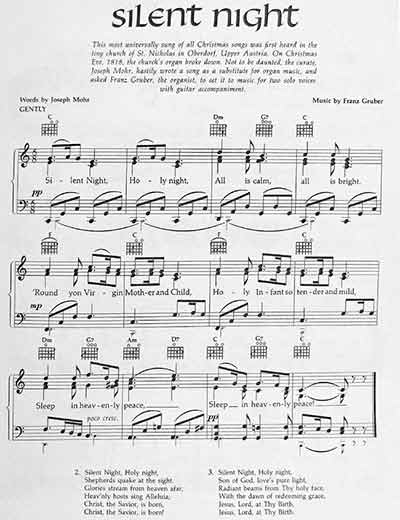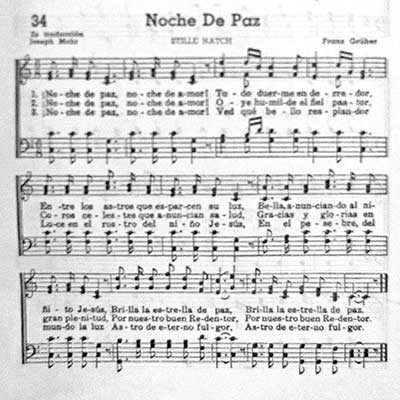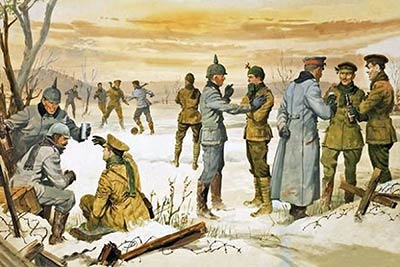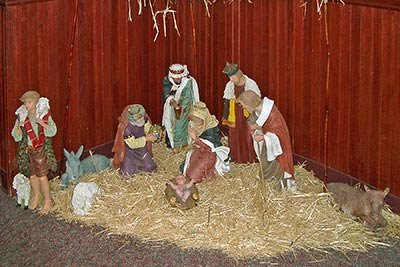SILENT NIGHT
Noche de Paz
By
Mary Hunt Webb
Posted Wednesday, November 30, 2016

"Silent Night" is sung throughout the world, particularly in December. [Photographer: Mary Hunt Webb.*]
From childhood, I remember singing "Silent Night" throughout December, but it wasn't until I played the Spanish version, "Noche de Paz", on the piano for a Spanish-speaking congregation that I began to understand that this particular carol transcends national borders so that it is sung throughout the world. When the melody of "Silent Night" plays to a multi-cultural audience, participants begin singing it in their native language because most people know at least the first verse by heart in their mother tongue.

"Silent Night" has been translated into approximately 140 languages so that it appears in hymnals and songbooks throughout the world. [Photographer: Mary Hunt Webb.*]
Originally written in German as "Stille Nacht", it has been translated into many different languages. Speakers of French know it as "Douce Nuit" while Italians sing "Astro del Ciel". All told, this favorite carol has been translated into approximately 140 languages. The English translation of the first three verses, with which most speakers of English are familiar, is the work of John Freeman Young, an Episcopal priest. In March 2011, UNESCO declared this song to be an intangible cultural heritage.
The history of this beloved carol began when a young priest, Father Joseph Mohr, wrote the lyrics in Mariapfarr, his father's hometown in the Salzburg Lungau region of Austria, before coming to Oberndorf bei Salzburg. It was in Oberndorf that he asked Franz Xaver Gruber, the schoolmaster and organist from the neighboring village of Arnsdorf, to compose a melody to accompany the German lyrics to "Stille Nacht". Gruber complied with Mohr's request, but when he went to play the song in the church for the Christmas Eve service of 1818, he learned that the organ was not working properly. Consequently, Gruber played it for the first time in church on the guitar. Since then, "Silent Night" has been played on a variety of musical instruments as diverse as the accordion and the harmonica.
Just under a hundred years later, "Silent Night" was already known internationally so that when German soldiers began singing it on Christmas Eve of 1914 on the battlefield in Flanders, British soldiers recognized the tune and joined in to sing it in English. Thus, "Silent Night" became part of the famous Christmas Truce of 1914 in which soldiers on both sides of the battle line laid down their weapons for an unofficial ceasefire in celebration of the birth of our Lord Jesus Christ.

This painting from The Bridgeman Art Library depicts the Christmas Truce of 1914 when soldiers from both sides of the battle line laid down their weapons during World War 1. [Image courtesy of The Bridgeman Art Library.]
If soldiers at war, speaking different languages, can lay down their weapons for a bit of peace at Christmas, can't we lay down our ideological differences for peace this Christmas in celebration of the birth of the Prince of Peace? For He is the One that Isaiah prophesied would come when he said, "For unto us a child is born, unto us a son is given: and the government shall be upon his shoulder: and his name shall be called Wonderful, Counsellor, The mighty God, The everlasting Father, The Prince of Peace." (Isaiah 9:6, King James Version)
May the Prince of Peace rule in our hearts, our lives, our homes, and our countries this Christmas and all year through.
BIBLE VERSE FOR THIS POSTING
Isaiah 9:6 — For unto us a child is born, unto us a son is given: and the government shall be upon his shoulder: and his name shall be called Wonderful, Counsellor, The mighty God, The everlasting Father, The Prince of Peace. (King James Version)
Isaías 9:6 — Porque un niño nos es nacido, hijo nos es dado, y el principado sobre su hombro; y se llamará su nombre Admirable, Consejero, Dios Fuerte, Padre Eterno, Príncipe de Paz. (Reina-Valera 1960).

May we never forget that Christmas began with the birth of a baby. [Photographer: Morris Webb, Jr.*]
* Please do not use our original photos without our permission. These include photos by Mary Hunt Webb, Morris Webb, Jr., Morris Webb, Sr., and C.B. Hunt. Thank you.
